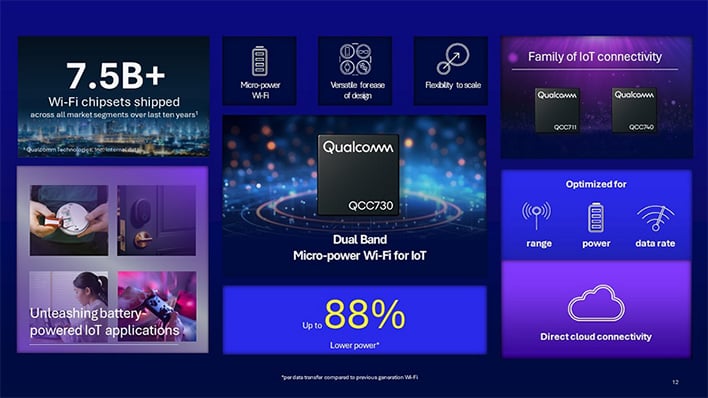For any smart home gadget to be useful, it needs to communicate with other connected devices. There are numerous ways to do that, including Zigbee, Thread, and Matter, but sometimes Wi-Fi is just easier than dealing with confusing IoT standards. The problem is Wi-Fi was not originally designed for low-power IoT devices. Qualcomm seems to have rectified that with its new QCC730 dual-band Wi-Fi system, however. The company claims this chip can keep gadgets connected without draining their batteries.
Wireless technologies like Zigbee were designed for power-constrained smart devices, and this technology works well under the right circumstances. You need a reliable hub to handle Zigbee connectivity, and that’s true of most IoT connectivity standards. You’ve probably already got Wi-Fi though, and that doesn’t require another hop to connect to the internet. Most IoT connectivity systems are not IP-based, so they can’t connect directly to the cloud. “QCC730 enables devices to support TCP/IP networking capabilities while remaining form-factor and complete wireless constrained, whilst remaining connected to the Cloud platforms,” explains Qualcomm’s Rahul Patel.
The Qualcomm QCC730 allows smart home devices to connect over Wi-Fi 6 while remaining online for long periods—faster Wi-Fi standards exist, but they they aren’t as efficient. Qualcomm promises devices using this chip will consume up to 88% less power than one using a traditional high-power Wi-Fi radio. It can even be used as an alternative to Bluetooth for connected accessories. There’s even an open source IDE and SDK to speed implementation.

This is not a chip you’re going to see listed on spec sheets like the latest Snapdragon, but it could still appear in plenty of devices. If anything, you’ll be less aware of the QCC730 than a comparable Zigbee or Z-wave solution, which usually require additional steps for pairing and management.
Qualcomm is showing off the new micro-power Wi-Fi chip at the Embedded World show. It hopes to get manufacturers interested in advance of sampling availability in June 2024. So, the best-case scenario for QCC730 products to hit the market is late this year. If the QCC730 doesn’t do what a potential customer requires, Qualcomm also offers other chips in the same family that can do Bluetooth (QCC711) or a raft of traditional smart home standards (QCC740).